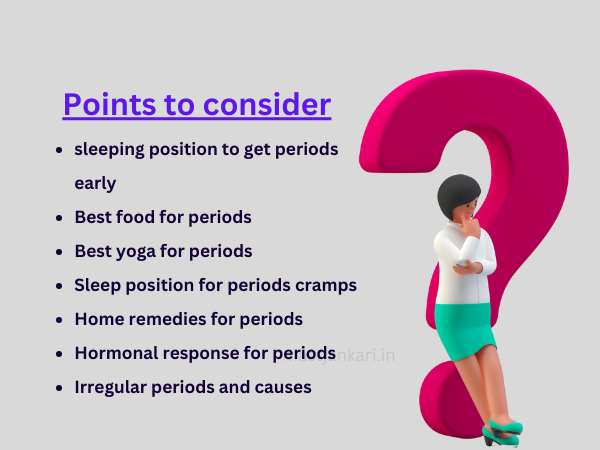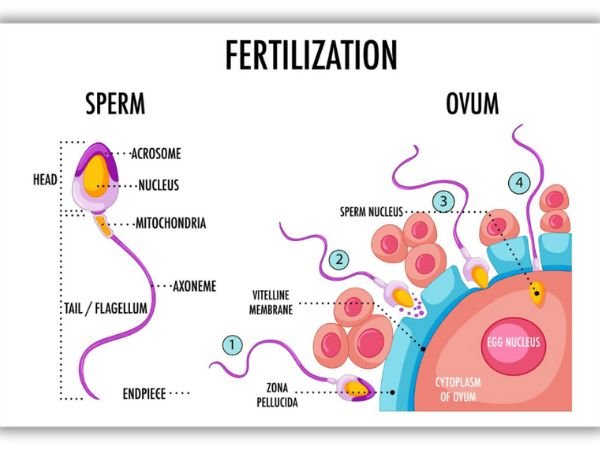What is the Sleeping position to get periods early
There is no scientifically proven sleeping position to get periods early, and the idea behind that specific sleeping positions can get periods early has no guaranteed evidence. Menstrual cycles are primarily regulated by hormonal fluctuations and various factors related to an individual’s health.

If you are experiencing irregular periods or have concerns about your menstrual health, it’s advisable to consult with a healthcare professional.
Hormones functions to get periods early:
1. Gonadotropin-Releasing Hormone (GnRH):
Function for Periods: Stimulates the release of FSH and LH, initiating the menstrual cycle.
2. Follicle-Stimulating Hormone (FSH):
Function for Periods: Stimulates the growth and development of ovarian follicles, preparing the eggs for potential fertilization.
3. Luteinizing Hormone (LH):
Function for Periods: Triggers ovulation, releasing a mature egg from the ovary.
4. Estrogen:
Function for Periods: Promotes the growth and thickening of the uterine lining (endometrium), preparing it for a potential fertilized egg.
5. Progesterone:
Function for Periods: Maintains the uterine lining after ovulation, supporting a potential pregnancy. If pregnancy does not occur, a decrease in progesterone leads to the shedding of the uterine lining (menstruation).
6. Human Chorionic Gonadotropin (hCG):
Function for Periods: If pregnancy occurs, hCG supports the corpus luteum, ensuring the continued production of progesterone and preventing menstruation.
Sleeping position to get periods early:
While there is limited scientific evidence to support the idea that specific sleeping position to get periods early. some people believe that certain positions, especially those that exert gentle pressure on the stomach, may help during menstruation. Keep in mind that individual experiences vary. Here are sleeping positions that some individuals find comforting during their periods:

Fetal sleeping position to get periods early:
- Curl up on your side with your knees drawn toward your chest.
- Benefits: This position can exert gentle pressure on the stomach and may help relieve abdominal discomfort.
Stomach Sleeping with Pillow Under Hips:
- Lie on your stomach with a pillow under your hips.
- Benefits: Some individuals find that this position can provide support to the lower abdomen and alleviate lower back pressure.
Reclined Butterfly Pose to get periods early:
- Lie on your back, bend your knees, and let them fall outward, bringing the soles of your feet together.
- Benefits: This pose opens the hip area and may exert gentle pressure on the lower abdomen.
Hugging a Pillow:
- Hug a pillow to your chest while lying on your side.
- Benefits: This position can provide a comforting sensation and may offer support to the stomach area.

Sleeping position during period to reduce cramps:
The discomfort of menstrual cramps can be challenging, especially when it comes to finding relief during sleep. Your sleeping position can significantly impact the severity of cramps and overall comfort. Here are some recommended sleeping positions to help alleviate menstrual cramps:
1. Fetal Position to reduce cramps during periods:
Curling up on your side with your knees drawn toward your chest.
Benefits: This position helps relieve pressure on the abdominal muscles, reducing tension and easing cramps. Place a pillow between your knees for added support.
2. Back Sleeping with Pillow Support:
Lie on your back with a pillow under your knees.
Benefits: Elevating your knees can help alleviate tension in the lower back and pelvic region, providing relief from cramps. Ensure proper pillow placement for comfort.
3. Side Sleeping with Body Pillow:
Lie on your side with a body pillow placed between your thighs.
Benefits: This position promotes spinal alignment and reduces strain on the lower back. The body pillow supports your hips and helps minimize discomfort associated with cramps.
4. Legs Up the Wall Pose (Viparita Karani):
Lie on your back and place your legs up against a wall, forming an L-shape.
Benefits: This gentle inversion can enhance blood circulation in the pelvic area, potentially reducing cramp intensity. Use a folded blanket or bolster under your hips for added support.
5. Reclined Butterfly Pose:
Lie on your back, bend your knees, and let them fall outward, bringing the soles of your feet together.
Benefits: This pose opens the hip area and stretches the inner thighs, providing relief from tension and cramps. Support your knees with pillows if needed.

6. Hugging a Pillow:
Hug a pillow to your chest while lying on your side.
Benefits: This position promotes relaxation and can ease tension in the abdominal muscles. Hugging a pillow provides a comforting sensation that may help distract from cramp discomfort.
7. Stomach Sleeping with Pillow Under Hips:
Lie on your stomach with a pillow under your hips.
Benefits: Placing a pillow under your hips helps maintain spinal alignment and reduces pressure on the lower abdomen, potentially easing cramps.
Tips for Enhanced Comfort:
- Use supportive pillows to maintain proper spinal alignment.
- Experiment with different positions to find what works best for you.
- Stay hydrated and maintain a comfortable room temperature for quality sleep.
- Consider using a heating pad on your lower abdomen for added relief.
Irregular periods symptoms:
Irregular Menstrual Cycles: Symptoms and Signs
Irregular periods signify a disruption in your typical menstrual cycle, manifesting as the occurrence of periods either well in advance or later than your anticipated date. This irregularity can manifest as both delayed or early periods, affecting the blood flow during menstruation and altering the duration of your menstrual cycle. Here are some prevalent symptoms associated with irregular periods:
- Frequent Bleeding Between Periods: Experiencing bleeding for several days between two consecutive periods is a common indicator of irregular menstrual cycles.
- Variations in Blood Flow: Irregular periods may lead to either excessive bleeding or unusually light blood flow during menstruation, highlighting the variability in menstrual patterns.
- Bleeding Beyond Menopause: An alarming symptom of irregular periods includes experiencing bleeding even after menopause, which warrants prompt medical attention.
- Extended or Shortened Menstrual Cycles: Irregularities can manifest as either prolonged or shortened menstruation cycles, further contributing to the complexity of menstrual health.
Irregular periods causes:
In the usual course of events, a menstrual cycle spans around 28 days, but deviations from this norm can lead to irregular periods. Lifestyle choices and certain health conditions often play a role in disrupting the menstrual cycle. Here are some common causes contributing to irregular periods:
- Polycystic Ovarian Syndrome (PCOS): PCOS manifests as the formation of small sac-like structures filled with fluids in the ovaries, causing dysfunction that leads to irregular menstrual cycles.
- Stress: Excessive stress prompts the body to release cortisol, disrupting hormonal balance and consequently impacting the regularity of the menstrual cycle.
- Underlying Diseases: Conditions such as thyroid disorders, diabetes, anorexia, and others can disrupt hormonal balance due to medication, resulting in irregular periods.
- Birth Control Pills: Particularly, emergency contraceptive pills can alter estrogen and progesterone hormone levels, influencing the menstrual cycle and contributing to irregular periods.
- Hormonal Imbalance: Sudden fluctuations in body weight, intense workout regimens, or insufficient sleep can lead to hormonal imbalances, contributing to irregular menstrual cycles alongside the effects of stress.
- Smoking and Drinking: The habit of smoking or excessive drinking can significantly impact menstrual regularity. Studies indicate that smoking may shorten the luteal phase of the menstrual cycle, causing variations in its length. Quitting smoking is advised for those seeking to restore regular periods.
When faced with irregular periods persisting for 2-3 months, consulting a gynecologist is paramount. A medical professional can discern the specific cause and recommend an effective treatment plan tailored to address the underlying issues. Seeking timely guidance ensures comprehensive menstrual health management.
Delay Periods Causes:
- Stress: Stress, the ever-present companion of modern life, can disrupt the hormonal ballet responsible for regulating periods, causing an occasional delay.
- Hormonal Imbalance: Hormones, can impact on the periods.
- PCOS (Polycystic Ovarian Syndrome): PCOS introduces small cysts as unexpected guests, disrupting the hormonal harmony and causing irregularities or delays in the menstrual cycle.
- Thyroid Problems: Thyroid issues act like a rogue conductor, throwing the hormonal orchestra out of rhythm and potentially causing delays in the menstrual composition.
- Menopause: Menopause marks the grand finale, but in the lead-up (perimenopause), periods might take unexpected pauses and delays.
- Pregnancy: Pregnancy naturally hits the pause button on the regular menstrual programming as the body shifts focus to nurture a potential new life.
- Overweight: Excess weight can tweak hormonal settings, occasionally leading to a shift in the timing of menstrual cycles.
- Contraceptives: Certain contraceptives, especially those with hormonal components, can play a role in reshaping the menstrual timeline.
Yoga for get periods early:
Certain yoga poses are support reproductive health and may potentially help with menstrual regularity but if you are looking for any exercise to get periods immediately in one hour then it is not possible, You can try if any of these exercise helps to get periods immediately in one hour but remeber that individual responses can vary. Yoga is generally considered beneficial for overall well-being, including supporting the reproductive system, reducing stress, and promoting hormonal balance. Here are some yoga poses that are often recommended:

Butterfly Pose (Baddha Konasana):
How to Do It:
- Duration: 1-5 minutes
- Sit with legs outstretched.
- Bend knees and bring soles of feet together.
- Hold feet with hands.
- Gently flap knees up and down.
Benefits: Butterfly pose is thought to stimulate the reproductive organs and improve blood circulation in the pelvic area.
Reclining Bound Angle Pose (Supta Baddha Konasana):
- Duration: 5-10 minutes
- Lie on back.
- Bring soles of feet together.
- Let knees fall to the sides.
- Support knees with props if needed.
Benefits: Similar to Butterfly pose, this reclined variation is believed to open the hips and promote relaxation.

Cat-Cow Stretch (Marjaryasana-Bitilasana):
- Start on your hands and knees.
- Duration: 1-3 minutes
- Start on hands and knees.
- Inhale, arch back (cow pose).
- Exhale, round back (cat pose).
Benefits: Cat-Cow helps improve the flexibility of the spine and may stimulate the reproductive organs.
Child’s Pose (Balasana):
- Duration: 2-5 minutes
- Kneel on mat.
- Sit back on heels.
- Extend arms forward.
- Rest forehead on the mat.
Benefits: Child’s pose is a resting position that helps release tension in the lower back and pelvic area.

Camel Pose (Ustrasana):
- Duration: 30 seconds to 1 minute
- Kneel with knees hip-width apart.
- Lean back.
- Reach for heels.
Benefits: Camel pose is believed to stretch the abdomen and improve blood flow to the pelvic region.
Upward-Facing Dog (Urdhva Mukha Svanasana):
- Duration: 15-30 seconds
- Lie on stomach.
- Place hands next to shoulders.
- Lift chest off the mat.
Benefits: This pose is thought to strengthen the pelvic muscles and improve circulation.

Bridge Pose (Setu Bandhasana):
- Duration: 30 seconds to 1 minute
- Lie on back.
- Bend knees.
- Lift hips toward the ceiling.
Benefits: Bridge pose is believed to stretch the spine, stimulate the abdominal organs, and improve circulation.
Remember, while yoga can be a valuable part of a holistic approach to wellness, it’s not a guaranteed method for inducing periods or addressing menstrual irregularities. If you have concerns about your menstrual health or experience persistent irregularities, it’s advisable to consult with a healthcare professional for personalized guidance
Best Food to get periods early:
It’s important to note that there is no conclusive scientific evidence that specific foods can reliably induce periods immediately. Menstrual cycles are complex and influenced by various factors. However, some foods are believed to have properties that may support menstrual health. It’s crucial to consult with a healthcare professional before attempting to use foods or supplements to manipulate menstrual cycles. Here are some foods that are commonly suggested:
Pineapple:
- How to Consume: Fresh pineapple or pineapple juice.
- How It Might Help: Pineapple contains bromelain, an enzyme that some believe may have anti-inflammatory properties, potentially supporting reproductive health.

Papaya:
- How to Consume: Fresh ripe papaya or papaya juice.
- How It Might Help: Papaya is thought to contain carotene, which may stimulate the production of estrogen, potentially influencing menstrual cycles.
Ginger:
- How to Consume: Fresh ginger in tea, raw, or as a supplement.
- How It Might Help: Ginger is believed to have anti-inflammatory properties that might help with menstrual cramps. It’s also thought to stimulate menstrual flow.

Turmeric:
- How to Consume: Turmeric can be added to foods, or you can take it as a supplement.
- How It Might Help: Turmeric contains curcumin, which is believed to have anti-inflammatory and antioxidant properties. Some suggest it may support menstrual health.
Cinnamon:
- How to Consume: Sprinkle cinnamon on food, add it to drinks, or take it as a supplement.
- How It Might Help: Cinnamon is thought to have anti-inflammatory and antispasmodic properties, potentially aiding in menstrual discomfort.

Dates:
- How to Consume: Eat dates as a snack or incorporate them into your diet.
- How It Might Help: Dates are rich in iron, which is essential for maintaining healthy blood levels. Adequate iron levels are important for overall menstrual health.
Fennel:
- How to Consume: Chew on fennel seeds or make fennel tea.
- How It Might Help: Fennel is believed to have phytoestrogens, which may influence hormonal balance.
Remember, individual responses to these foods can vary, and their effects on menstrual cycles are not guaranteed. It’s advisable to focus on maintaining a balanced and nutritious diet for overall health. If you’re experiencing irregular periods or have concerns about your menstrual health, it’s best to consult with a healthcare professional.
massage to get periods immediately in one hour:
There is no scientific evidence to support the idea that massage alone can induce periods. Menstrual cycles are complex and influenced by various factors, including hormonal changes, stress levels, and overall health. However, certain types of massage may promote relaxation, reduce stress, and improve blood circulation, which can contribute to overall well-being. Here are some types of massage that are generally considered safe and relaxing.
Abdominal Massage:
- Technique: Gently massage your lower abdomen in a circular motion with your fingertips. Use light to moderate pressure.
- Potential Benefits: Abdominal massage may help relax the pelvic muscles and improve blood circulation in the pelvic area.
Full Body Massage:
- Technique: A full-body massage, performed by a licensed massage therapist, can include various techniques such as Swedish massage or deep tissue massage.
- Potential Benefits: Full-body massage may reduce overall stress, promote relaxation, and improve blood flow throughout the body.
Foot Reflexology:
- Technique: Massage specific points on the feet that are believed to correspond to different organs and systems in the body, including the reproductive system.
- Potential Benefits: Reflexology is thought to stimulate various body functions and promote balance.
Back Massage:
- Technique: Focus on the lower back area and apply gentle pressure to the muscles.
- Potential Benefits: Back massage can help alleviate tension in the lower back, which may indirectly contribute to relaxation in the pelvic region.
While massage can be a soothing and enjoyable part of self-care. If you are experiencing irregular periods or have concerns about your menstrual health, it’s advisable to consult with a healthcare professional.
Tablets to get periods immediately if delayed:
If you are searching for tablets to get periods immediately if delayed then you should only be done under the guidance and supervision of a qualified healthcare professional. Attempting to induce pregnancy without proper medical advice can lead to serious health risks and complications. There are some tablets to get periods immediately to avoid pregnancy but always consider under the guidance of Doctor.
- Clomiphene Citrate (Clomid): This medication is often used to stimulate ovulation in women who have irregular or absent menstrual cycles.
- Letrozole (Femara): Another medication used to induce ovulation, especially in cases where Clomiphene is not effective or well-tolerated.
- Human Chorionic Gonadotropin (hCG): This hormone is sometimes used to trigger ovulation in conjunction with fertility treatments.
It’s crucial to consult with a fertility specialist or reproductive endocrinologist who can assess your specific situation, conduct necessary tests, and recommend appropriate treatments. Self-prescribing or using medications without proper medical guidance can be unsafe and is not recommended.
Is it safe to take medications to induce periods?
It is generally safe to take medications to induce periods, but this decision should be made in consultation with a healthcare professional. Common medications include hormonal contraceptives. It’s crucial to identify the underlying cause (hormonal imbalances, polycystic ovarian syndrome (PCOS), thyroid disorders, stress, or other medical conditions) of irregular periods and consider potential side effects and individual health history. Regular follow-up with a healthcare provider is important for monitoring and adjusting the treatment plan if needed.
Home remedies to get periods immediately:
Are you searchinf for home remedies to get periods immediately then here is a Natural Ways to Encourage Menstruation, try these Home Remedies for Quick Periods. The journey of seeking natural methods to regulate menstrual cycles and induce menstruation is a common quest. It’s crucial to remember that while these home remedies may be effective for some, they are not a substitute for professional medical advice or treatment. Here’s a friendly guide to a few natural ways on how to encourage menstruation naturally:

1. Cumin:
How it Works: Cumin, a spice with estrogen-like properties, is believed to stimulate the uterus, potentially inducing menstruation.
Try This: Make cumin tea by adding 1 teaspoon of cumin seeds to a cup of boiling water. Let it steep for 10 minutes, strain, and drink. Consume for 2-3 days before the expected date of menstruation.
2. Papaya:
How it Works: Raw papaya contains carotene, which stimulates the production of the estrogen hormone, encouraging contractions in the uterus and promoting early periods.
Try This: Consume papaya juice or eat fresh ripe papaya twice a day—approximately one cup of juice (200 ml) or two bowls of papaya during the day.
3. Ginger:
How it Works: Ginger, known for its warming properties, can stimulate menstrual flow and promote contractions in the uterus.
Try This: Drink fresh ginger juice with honey or ginger tea. Consume a cup of fresh ginger juice with water (2:1) on an empty stomach for a few days before your expected date.
4. Parsley:
How it Works: Parsley contains compounds believed to stimulate the uterus, potentially bringing on menstruation.
Try This: Make parsley tea by adding 1 tablespoon of chopped fresh parsley to a cup of boiling water. Steep for 10 minutes, strain, and drink for 2-3 days before the expected date.

5. Carom Seeds (Ajwain):
How it Works: Carom seeds, or ajwain, are thought to stimulate menstrual bleeding by promoting blood flow to the uterus and relaxing pelvic muscles.
Try This: Boil 1 tsp carom seeds with 1 tsp jaggery in 1 glass of water and consume it on an empty stomach in the morning.
6. Fennel Seeds:
How it Works: Phytoestrogens in fennel seeds are believed to stimulate the uterus and promote blood flow to the pelvic area.
Try This: Mix 2 tsp of fennel seeds in a glass of water, leave it overnight, strain, and have it in the morning.
7. Fenugreek Seeds:
How it Works: Fenugreek seeds may influence menstruation by various methods, but it’s crucial to consult with a healthcare professional before use.
Try This: Soaked seeds, powdered seeds, or fenugreek tea can be consumed under guidance.
8. Food Rich in Vitamin C:
How it Works: Vitamin C may promote menstruation by increasing estrogen production and reducing inflammation in the body.
Include in Your Diet: Consume foods rich in vitamin C to support menstrual regulation naturally.
Remember, while these natural remedies may offer support, consulting a healthcare professional is advisable, especially if you’re experiencing persistent irregularities. They can provide personalized guidance based on your health needs.
Citrus Fruits:
- Oranges
- Grapefruits
- Lemons
- Limes
Berries:
- Strawberries
- Blueberries
- Raspberries
- Blackberries
- Cranberries
Tropical Fruits:
- Pineapple
- Mango
- Papaya
- Kiwi
Citrus-Like Fruits:
- Guava
- Acerola cherries
- Passion fruit
What should avoid:
During menstruation, individuals may experience discomfort and hormonal fluctuations. While there are no strict rules about what to avoid, but certain practices or habits can help alleviate symptoms and promote overall well-being during their periods.
- Highly Processed Foods:
- Excessive Caffeine:
- Sugary Foods:
- Fatty Foods:
- Excessive Salt:
- Inadequate Hydration:
- Skipping Meals:
- Strenuous Exercise (for some):
- Tight Clothing:
Common question that are mostly searched by peoples
पीरियड्स नहीं आ रहे हैं तो क्या करें?
पीरियड्स ना आने के कई कारण हो सकते हैं और इस पर कभी-कभी सही समय पर चिकित्सा का सहारा लेना उचित हो सकता है। यहां कुछ सामान्य सुझाव दिए जा रहे हैं:
- डॉक्टर से परामर्श करें: यदि आपके पीरियड्स नियमित नहीं हो रहे हैं, तो सबसे पहले एक डॉक्टर से मिलें। वह आपके स्वास्थ्य का पूरा परीक्षण करेंगे और सही निदान लगाएंगे।
- स्वस्थ आहार: सही और पूरा पोषण प्राप्त करना महत्वपूर्ण है। सुनिश्चित करें कि आपका आहार विभिन्न पोषण सामग्रियों से भरपूर है, जैसे कि फल, सब्जियां, दालें, और अन्य प्रोटीन स्रोत।
- नियमित व्यायाम: स्वस्थ रहने के लिए नियमित व्यायाम करना फायदेमंद हो सकता है। यह स्त्री हॉर्मोन्स को संतुलित करने में मदद कर सकता है जो पीरियड्स के नियमित आने में मदद कर सकते हैं।
- तनाव का प्रबंधन: तनाव भी पीरियड्स को प्रभावित कर सकता है। सुनिश्चित करें कि आप तनाव को संभालने के लिए योग और ध्यान जैसी तकनीकों का इस्तेमाल कर रहे हैं।
- अगर गर्भावस्था का खतरा हो: यदि आपके प्रतिस्पर्धी गर्भावस्था का खतरा है, तो डॉक्टर से संपर्क करें।
- धूम्रपान और शराब की शीतलकरण: धूम्रपान और शराब की शीतलकरण से बचें, क्योंकि ये पीरियड्स को प्रभावित कर सकते हैं।
यदि आपके पीरियड्स नियमित नहीं हैं और आप चिंतित हैं, तो सर्वश्रेष्ठ होगा कि आप एक प्रशिक्षित चिकित्सक से मासिक धर्म स्वास्थ्य की जाँच करवाएं और उनसे सलाह लें।
What to do if periods are not coming?
If your periods are not coming and you’re concerned, here are some steps you can take:
- Consult a Healthcare Professional: Schedule an appointment with a healthcare provider, such as a gynecologist or family doctor, to discuss your concerns. They can conduct a thorough examination and provide personalized advice.
- Medical History: Share your complete medical history, including any changes in lifestyle, stress levels, medications, or other factors that might be affecting your menstrual cycle.
- Physical Examination: A physical examination may be conducted to assess your overall health, including factors that could be influencing your menstrual cycle.
- Lab Tests: Your healthcare provider might recommend blood tests to check hormone levels, thyroid function, and other factors that could be related to irregular periods.
- Pelvic Ultrasound: In some cases, a pelvic ultrasound may be performed to assess the health of reproductive organs and identify any abnormalities.
- Lifestyle Changes: Evaluate and make positive changes to your lifestyle, including maintaining a balanced diet, getting regular exercise, managing stress, and ensuring adequate sleep.
- Birth Control: Depending on your situation, your healthcare provider might suggest hormonal birth control methods to regulate your menstrual cycle.
- Addressing Underlying Issues: If an underlying medical condition is identified, your healthcare provider will work with you to address and manage it effectively.
- Pregnancy Test: If there is a possibility of pregnancy, a pregnancy test may be recommended to rule out or confirm pregnancy as the cause of missed periods.
References
- For yoga and food idea : uvihealth.in
- Home remedies for periods
- Irregular periods symptoms : flebo.in
- Windham GC;Elkin EP;Swan SH;Waller KO;Fenster L; (no date) Cigarette smoking and effects on menstrual function, Obstetrics and gynecology. (Accessed: 01 August 2023) Available at: https://pubmed.ncbi.nlm.nih.gov/9916957/
- Ubukata, H. and Matsumura, A. (2015) Relationship between the phases of the menstrual cycle and the transversus abdominis muscle, Journal of physical therapy science. (Accessed: 01 August 2023). Available at: https://www.ncbi.nlm.nih.gov/pmc/articles/PMC4395665/
- NISCPR Online Periodical Repository: Home (no date) NIScPR Online Periodical Repository: Home. (Accessed: 01 August 2023) Available at: https://nopr.niscpr.res.in/
Disclaimer : Our content is only for informational purpose . please consult a doctor before doing anything that mension in the article. we are not a doctor or adviser.






